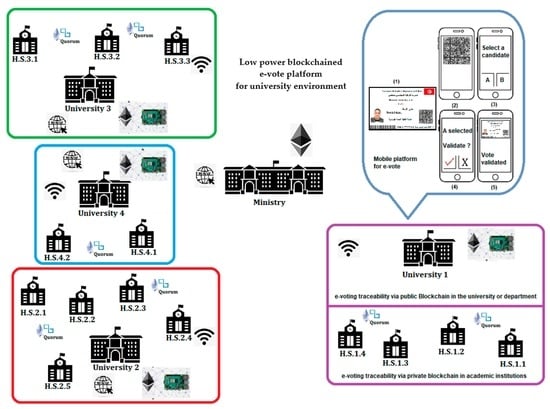Low Power Blockchained E-Vote Platform for University Environment
Abstract
:1. Introduction
- − This system will allow students to vote remotely in order to elect their representative.
- − It is a secure system by design (Blockchain) and by mobility (remote voting).
- − The result which minimizes the risk of error or fraud is generated automatically.
2. Ease of Use
2.1. Blockchain Application
- − Reliability: one of the strengths of decentralization is the minimization of damage from attacks.
- − Trustlessness: thanks to decentralization, the information exchange is realized without the need for a third party.
- − Integrity: based on a control protocol, the execution of transactions is achieved. This ensures its integrity.
- − Transparency: all transactions made to the chains are public, immutable and can be controlled and accessed by all nodes of the Blockchain.
- − Exchange
- − Energy Industry
- − Insurance
- − Healthcare
- − Industry
- − Agriculture
- − Education
2.2. Applied Blockchain to E-Vote
- − Blockchain technology as a development platform and blockchain network. The Ethereum network provides a wide range of use cases, with the power of smart contracts. It is a platform where we can use tokens to build and run decentralized applications and create smart contracts.
- − ML for automating the verification process of eligible voters using machine learning service of an AI-powered oracle platform for face authentication which helps enhance user experience.
2.3. Low Power Platform
3. Proposed Approach
3.1. General System
3.2. Particular University System
- Facilitate the implementation of a secure election system.
- Create an efficient system respecting the social distancing in this period of COVID-19.
3.3. E-Vote Methodology
4. Obtained Results
4.1. E-Vote Proposed Hardware
4.2. E-Vote Steps
- The voter must have their student card at their disposal.
- Thanks to our application, the candidate scans the QR code present on their student card.
- If the candidate has already voted, he/she will not be able to access the platform; otherwise, he/she will have the choice between the candidates (in our application we have chosen two candidates.)
- After choosing, a validation request of the candidate is sent to the voter.
- Following this validation, an image of the student’s card and a confirmation of their vote are displayed on the application.
4.3. Quorum on Raspberry PI
4.4. Ethereum Implementation PI
4.4.1. Node Package Manager
4.4.2. Truffle Framework
4.4.3. Ganache
4.4.4. MetaMask
4.5. Build Interaction with the Smart Contract
5. Low Power Discussion
6. Conclusions
Author Contributions
Funding
Data Availability Statement
Conflicts of Interest
References
- Ben Fekih, R.; Lahami, M. Application of Blockchain Technology in Healthcare: A Comprehensive Study. In International Conference on Smart Homes and Health Telematics; Springer: Cham, Switzerland, 2020; pp. 268–276. [Google Scholar]
- Frikha, T.; Chaari, A.; Chaabane, F.; Cheikhrouhou, O.; Zaguia, A. Healthcare and Fitness Data Management Using the IoT-Based Blockchain Platform. J. Healthc. Eng. 2021, 2021, 9978863. [Google Scholar] [CrossRef] [PubMed]
- Frikha, T.; Chaabane, F.; Aouinti, N.; Cheikhrouhou, O.; Ben Amor, N.; Kerrouche, A. Implementation of Blockchain Consensus Algorithm on Embedded Architecture. Secur. Commun. Netw. 2021, 2021, 9918697. [Google Scholar] [CrossRef]
- Erol, I.; Neuhofer, I.O.; Dogru, T.; Oztel, A.; Searcy, C.; Yorulmaz, A.C. Improving sustainability in the tourism industry through blockchain technology: Challenges and opportunities. Tour. Manag. 2022, 93, 104628. [Google Scholar] [CrossRef]
- Ktari, J.; Frikha, T.; Hamdi, M.; Elmannai, H.; Hmam, H. Lightweight AI Framework for Industry 4.0 Case Study: Water Meter Recognition. Big Data Cogn. Comput. 2022, 6, 72. [Google Scholar] [CrossRef]
- Li, Z.; Zhong, R.Y.; Tian, Z.; Dai, H.-N.; Barenji, A.V.; Huang, G.Q. Industrial Blockchain: A state-of-the-art Survey. Robot. Comput. Manuf. 2021, 70, 102124. [Google Scholar] [CrossRef]
- Demestichas, K.; Peppes, N.; Alexakis, T.; Adamopoulou, E. Blockchain in Agriculture Traceability Systems: A Review. Appl. Sci. 2020, 10, 4113. [Google Scholar] [CrossRef]
- Harshitha, M.S.; Shashidhar, R.; Roopa, M. Block chain based agricultural supply chain-A review. Glob. Transit. Proc. 2021, 2, 220–226. [Google Scholar] [CrossRef]
- Xue, L.; Fu, R.; Lin, D.; Kuok, K.; Huang, C.; Su, J.; Hong, W. Exploring the Innovative Blockchain-Based Application of Online Learning System in University. In International Conference on Web-Based Learning; Springer: Cham, Switzerland, 2021; pp. 90–101. [Google Scholar] [CrossRef]
- Allouche, M.; Frikha, T.; Mitrea, M.; Memmi, G.; Chaabane, F. Lightweight Blockchain Processing. Case Study: Scanned Document Tracking on Tezos Blockchain. Appl. Sci. 2021, 11, 7169. [Google Scholar] [CrossRef]
- Schollmeier, R. A definition of peer-to-peer networking for the classification of peer-to-peer architectures and applications. In Proceedings of the First International Conference on Peer-to-Peer Computing, Linkoping, Sweden, 27–29 August 2001; pp. 101–102. [Google Scholar] [CrossRef]
- Bradbury, D. Blockchain’s. Eng. Technol. 2016, 11, 44–47. [Google Scholar] [CrossRef]
- Acharjamayum, I.; Patgiri, R.; Devi, D. Blockchain: A Tale of Peer to Peer Security. In Proceedings of the 2018 IEEE Symposium Series on Compu-tational Intelligence (SSCI), Bangalore, India, 18–21 November 2018; pp. 609–617. [Google Scholar] [CrossRef]
- Casino, F.; Dasaklis, T.K.; Patsakis, C. A systematic literature review of blockchain-based applications: Current status, classification and open issues. Telemat. Inform. 2018, 36, 55–81. [Google Scholar] [CrossRef]
- Yang, J.; Paudel, A.; Gooi, H.B. Compensation for Power Loss by a Proof-of-Stake Consortium Blockchain Microgrid. IEEE Trans. Ind. Inform. 2020, 17, 3253–3262. [Google Scholar] [CrossRef]
- Wu, Y.; Wu, Y.; Cimen, H.; Vasquez, J.C.; Guerrero, J.M. Towards collective energy Community: Potential roles of microgrid and blockchain to go beyond P2P energy trading. Appl. Energy 2022, 314, 119003. [Google Scholar] [CrossRef]
- Wang, X.; Yao, F.; Wen, F. Applications of Blockchain Technology in Modern Power Systems: A Brief Survey. Energies 2022, 15, 4516. [Google Scholar] [CrossRef]
- Gatteschi, V.; Lamberti, F.; Demartini, C.; Pranteda, C.; Santamaría, V. Blockchain and Smart Contracts for Insurance: Is the Technology Mature Enough? Futur. Internet 2018, 10, 20. [Google Scholar] [CrossRef]
- Chondrogiannis, E.; Andronikou, V.; Karanastasis, E.; Litke, A.; Varvarigou, T. Using blockchain and semantic web technologies for the implementation of smart contracts between individuals and health insurance organizations. Blockchain Res. Appl. 2022, 3, 100049. [Google Scholar] [CrossRef]
- Ktari, J.; Frikha, T.; Ben Amor, N.; Louraidh, L.; Elmannai, H.; Hamdi, M. IoMT-Based Platform for E-Health Monitoring Based on the Blockchain. Electronics 2022, 11, 2314. [Google Scholar] [CrossRef]
- Elangovan, D.; Long, C.; Bakrin, F.S.; Tan, C.S.; Goh, K.; Ming, L.C. The Use of Blockchain Technology in the Health Care Sector: Systematic Review. JMIR Med. Inform. 2022, 10, e17278. [Google Scholar] [CrossRef]
- Fatima, N.; Agarwal, P.; Sohail, S.S. Security and Privacy Issues of Blockchain Technology in Health Care—A Review. In ICT Analysis and Applications; Springer: Cham, Switzerland, 2022; pp. 193–201. [Google Scholar] [CrossRef]
- Gambril, J.; Boyd, C.; Egbaria, J. Application of Nonfungible Tokens to Health Care. Comment on Blockchain Technology Projects to Provide Telemedical Services: Systematic Review. J. Med. Internet Res. 2022, 24, e34276. [Google Scholar] [CrossRef]
- Frikha, T.; Abdennour, N.; Chaabane, F.; Ghorbel, O.; Ayedi, R.; Shahin, O.R.; Cheikhrouhou, O. Source Localization of EEG Brainwaves Activities via Mother Wavelets Families for SWT Decomposition. J. Health Eng. 2021, 2021, 9938646. [Google Scholar] [CrossRef]
- Chen, Y.; Lu, Y.; Bulysheva, L.; Kataev, M.Y. Applications of Blockchain in Industry 4.0: A Review. Inf. Syst. Front. 2022, 1–15. [Google Scholar] [CrossRef]
- Wamba, S.F.; Queiroz, M.M. Industry 4.0 and the supply chain digitalisation: A blockchain diffusion perspective. Prod. Plan. Control 2020, 33, 193–210. [Google Scholar] [CrossRef]
- Alamsyah, A.; Hakim, N.; Hendayani, R. Blockchain-Based Traceability System to Support the Indonesian Halal Supply Chain Ecosystem. Economies 2022, 10, 134. [Google Scholar] [CrossRef]
- Vyas, S.; Shabaz, M.; Pandit, P.; Parvathy, L.R.; Ofori, I. Integration of Artificial Intelligence and Blockchain Technology in Healthcare and Agriculture. J. Food Qual. 2022, 2022, 4228448. [Google Scholar] [CrossRef]
- Alobid, M.; Abujudeh, S.; Szűcs, I. The Role of Blockchain in Revolutionizing the Agricultural Sector. Sustainability 2022, 14, 4313. [Google Scholar] [CrossRef]
- Praveen, P.; Shaik, M.A.; Kumar, T.S.; Choudhury, T. Smart Farming: Securing Farmers Using Block Chain Technology and IOT. In Blockchain Applications in IoT Ecosystem; Springer: Cham, Switzerland, 2021; pp. 225–238. [Google Scholar] [CrossRef]
- Guo, C.; Zi, Y.; Ren, W. A Blockchain Based Framework for Smart Greenhouse Data Management. In International Conference on Knowledge Science, Engineering and Management; Springer: Cham, Switzerland, 2021; pp. 299–310. [Google Scholar] [CrossRef]
- Khan, A.A.; Laghari, A.A.; Shaikh, A.A.; Bourouis, S.; Mamlouk, A.M.; Alshazly, H. Educational Blockchain: A Secure Degree Attestation and Verification Traceability Architecture for Higher Education Commission. Appl. Sci. 2021, 11, 10917. [Google Scholar] [CrossRef]
- Vote, F.M. The Secure Mobile Voting Platform of The Future—Follow My Vote. 2020. Available online: https://followmyvote.com/ (accessed on 28 July 2020).
- Voatz. Voatz—Voting Redefined®. 2020. Available online: https://voatz.com (accessed on 28 July 2020).
- Polyas. Polyas. 2015. Available online: https://www.polyas.com (accessed on 28 July 2020).
- Agora. Agora. 2020. Available online: https://www.agora.vote (accessed on 28 July 2020).
- Zhang, S.; Wang, L.; Xiong, H. Chaintegrity: Blockchain-enabled large-scale e-voting system with robustness and universal verifiability. Int. J. Inf. Secur. 2019, 19, 323–341. [Google Scholar] [CrossRef]
- Lai, W.J.; Hsieh, Y.C.; Hsueh, C.W.; Wu, J.L. Date: A decentralized, anonymous and transparent e-voting system. In Proceedings of the 2018 1st IEEE International Conference on Hot Information-Centric Networking (HotICN), Shenzhen, China, 15–17 August 2018. [Google Scholar]
- Shahzad, B.; Crowcroft, J. Trustworthy Electronic Voting Using Adjusted Blockchain Technology. IEEE Access 2019, 7, 24477–24488. [Google Scholar] [CrossRef]
- Yi, H. Securing e-voting based on blockchain in P2P network. EURASIP J. Wirel. Commun. Netw. 2019, 2019, 137. [Google Scholar] [CrossRef]
- AlAbri, R.; Shaikh, A.K.; Ali, S.; Al-Badi, A.H. Designing an E-Voting Framework Using Blockchain Technology: A Case Study of Oman. Int. J. Electron. Gov. Res. 2022, 18, 1–29. [Google Scholar] [CrossRef]
- Rathee, G.; Iqbal, R.; Waqar, O.; Bashir, A.K. On the Design and Implementation of a Blockchain Enabled E-Voting Application Within IoT-Oriented Smart Cities. IEEE Access 2021, 9, 34165–34176. [Google Scholar] [CrossRef]
- Roopak, T.; Sumathi, R. Electronic Voting based on Virtual ID of Aadhar using Blockchain Technology. In Proceedings of the 2nd International Conference on Innovative Mechanisms for Industry Applications (ICIMIA), Bangalore, India, 5–7 March 2020; pp. 71–75. [Google Scholar] [CrossRef]
- Krishna, S.B.; Arvindh, M.P.; Alagappan, M. Secured Electronic Voting System Using the Concepts of Blockchain. In Proceedings of the IEEE 10th Annual Information Technology, Electronics and Mobile Communication Conference (IEMCON), Vancouver, BC, Canada, 17–19 October 2019; pp. 675–681. [Google Scholar] [CrossRef]
- Singh, A.; Chatterjee, K. SecEVS: Secure Electronic Voting System Using Blockchain Technology. In Proceedings of the International Conference on Computing, Power and Communication Technologies (GUCON), Greater Noida, India, 28–29 September 2018; pp. 863–867. [Google Scholar] [CrossRef]
- Dery, L.; Tassa, T.; Yanai, A.; Zamarin, A. A secure voting system for score based elections. In Proceedings of the 2021 ACM SIGSAC Conference on Computer and Communications Security (Virtual), Korea, 15–19 November 2021; pp. 2399–2401. [Google Scholar]
- El-Gburi, J.; Srivastava, G.; Mohan, S. Secure voting system for elections. Int. J. Comput. Aided Eng. Technol. 2022, 16, 497–511. [Google Scholar] [CrossRef]
- El Fezzazi, A.; Adadi, A.; Berrada, M. Towards a Blockchain based Intelligent and Secure Voting. In Proceedings of the 2021 Fifth International Conference on Intelligent Computing in Data Sciences (ICDS), Fez, Morocco, 20–22 October 2021; pp. 1–8. [Google Scholar]
- Gao, S.; Zheng, D.; Guo, R.; Jing, C.; Hu, C. An Anti-Quantum E-Voting Protocol in Blockchain with Audit Function. IEEE Access 2019, 7, 115304–115316. [Google Scholar] [CrossRef]
- McCorry, P.; Shahandashti, S.F.; Hao, F. A smart contract for boardroom voting with maximum voter privacy. In Proceedings of the International Conference on Financial Cryptography and Data Security, Sliema, Malta, 3–7 April 2017. [Google Scholar]
- Ktari, J.; Abid, M. A Low Power Design Methodology Based on High Level Models. In Proceedings of the International Conference on Embedded Systems & Applications, Las Vegas, NV, USA, 14–17 July 2008; pp. 10–15. [Google Scholar]
- Ktari, J.; Abid, M. System Level Power and Energy Modeling for Signal Processing Applications. In Proceedings of the 2nd IEEE International Design and Test Workshop, Cairo, Egypt, 16–18 December 2007; pp. 218–221. [Google Scholar] [CrossRef]
- Loghin, D.; Chen, G.; Dinh, T.; Ooi, B.C.; Teo, Y.M. Blockchain Goes Green? An Analysis of Blockchain on Low-Power Nodes. arXiv 2019, arXiv:1905.06520. [Google Scholar]
- Ktari, J.; Abid, M. A Low Power Design Space Exploration Methodology Based on High Level Models and Confidence Intervals. J. Low Power Electron. 2009, 5, 17–30. [Google Scholar] [CrossRef]
- Dammak, B.; Turki, M.; Cheikhrouhou, S.; Baklouti, M.; Mars, R.; Dhahbi, A. LoRaChainCare: An IoT Architecture Integrating Blockchain and LoRa Network for Personal Health Care Data Monitoring. Sensors 2022, 22, 1497. [Google Scholar] [CrossRef]
- Islam, M.R.; Rashid, M.M.; Rahman, M.A.; Mohamad, M.H. A Comprehensive Analysis of Blockchain-based Cryptocurrency Mining Impact on Energy Consumption. Int. J. Adv. Comput. Sci. Appl. 2022, 13, 590–598. [Google Scholar] [CrossRef]
- Kaup, F.; Gottschling, P.; Hausheer, D. PowerPi: Measuring and modeling the power consumption of the Raspberry Pi. In Proceedings of the 39th Annual IEEE Conference on Local Computer Networks, Edmonton, AB, Canada, 8–11 September 2014; pp. 236–243. [Google Scholar] [CrossRef]
- Ktari, J.; Frikha, T.; Yousfi, M.A.; Belghith, M.K.; Sanei, N. Embedded Keccak implementation on FPGA. In Proceedings of the 2022 IEEE International Conference on Design & Test of Integrated Micro & Nano-Systems (DTS), Cairo, Egypt, 6–9 June 2022; pp. 1–5. [Google Scholar]
- Loukil, K.; Khalfa, M.; Jmal, M.W.; Frikha, T.; Abid, M. Design and test of smart IP-camera within reconfigurable platform. In Proceedings of the 2017 2nd International Conference on Anti-Cyber Crimes (ICACC), Abha, Saudi Arabia, 26–27 March 2017; pp. 25–29. [Google Scholar]
- Frikha, T.; Ben Amor, N.; Diguet, J.-P.; Abid, M. A novel Xilinx-based architecture for 3D-graphics. Multimed. Tools Appl. 2018, 78, 14947–14970. [Google Scholar] [CrossRef]
- Sankaran, S.; Sanju, S.; Achuthan, K. Towards Realistic Energy Profiling of Blockchains for Securing Internet of Things. In Proceedings of the 38th IEEE International Conference on Distributed Computing Systems, Vienna, Austria, 2–6 July 2018; pp. 1454–1459. [Google Scholar] [CrossRef]
- Han, S.; Xu, Z.; Chen, L. Jupiter: A Blockchain Platform for Mobile Devices. In Proceedings of the 34th IEEE International Conference on Data Engineering (ICDE), Paris, France, 16–19 April 2018; pp. 1649–1652. [Google Scholar]
- Tudor, B.M.; Teo, Y.M. On understanding the energy consumption of ARM-based multicore servers. In Proceedings of the International Conference on Measurement and Modeling of Computer Systems (SIGMETRICS), Pittsburgh, PA, USA, 17–21 June 2013; ACM Press: New York, NY, USA, 2013; p. 267. [Google Scholar]
- Ge, Z.; Loghin, D.; Ooi, B.; Ruan, P.; Wang, T. Hybrid blockchain database systems: Design and performance. Proc. VLDB Endow. 2022, 15, 1092–1104. [Google Scholar] [CrossRef]
- Raspberry Pi Tutorials. Available online: https://raspberrypi-tutorials.fr/ (accessed on 9 July 2022).
- Ethereum. Available online: https://ethereum.org/en/ (accessed on 9 July 2022).
- ConsenSys Quorum. Available online: https://consensys.net/quorum/ (accessed on 9 July 2022).
- Ganache. Overview—Truffle Suite. Available online: https://trufflesuite.com/docs/ganache/ (accessed on 10 October 2021).
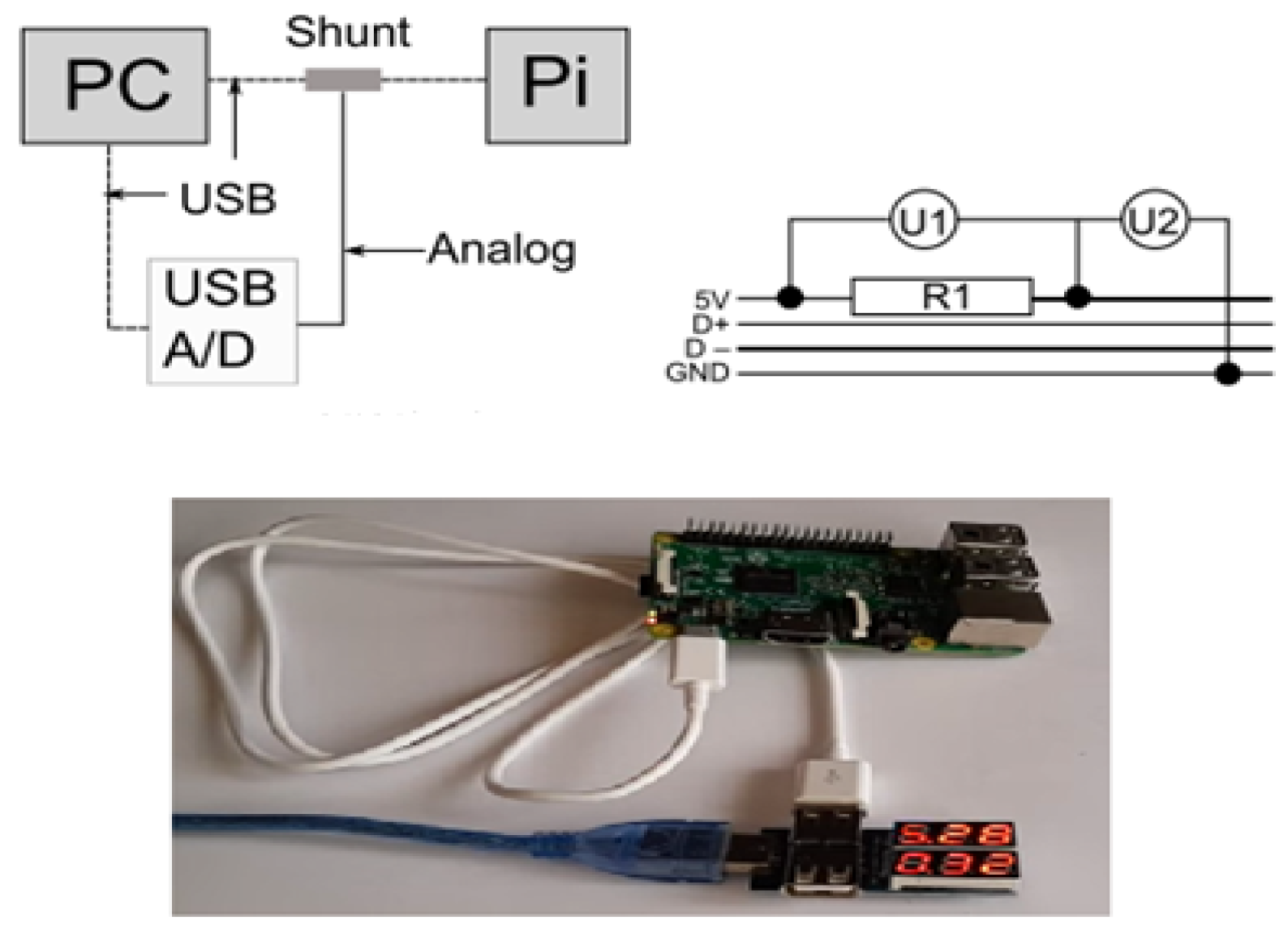

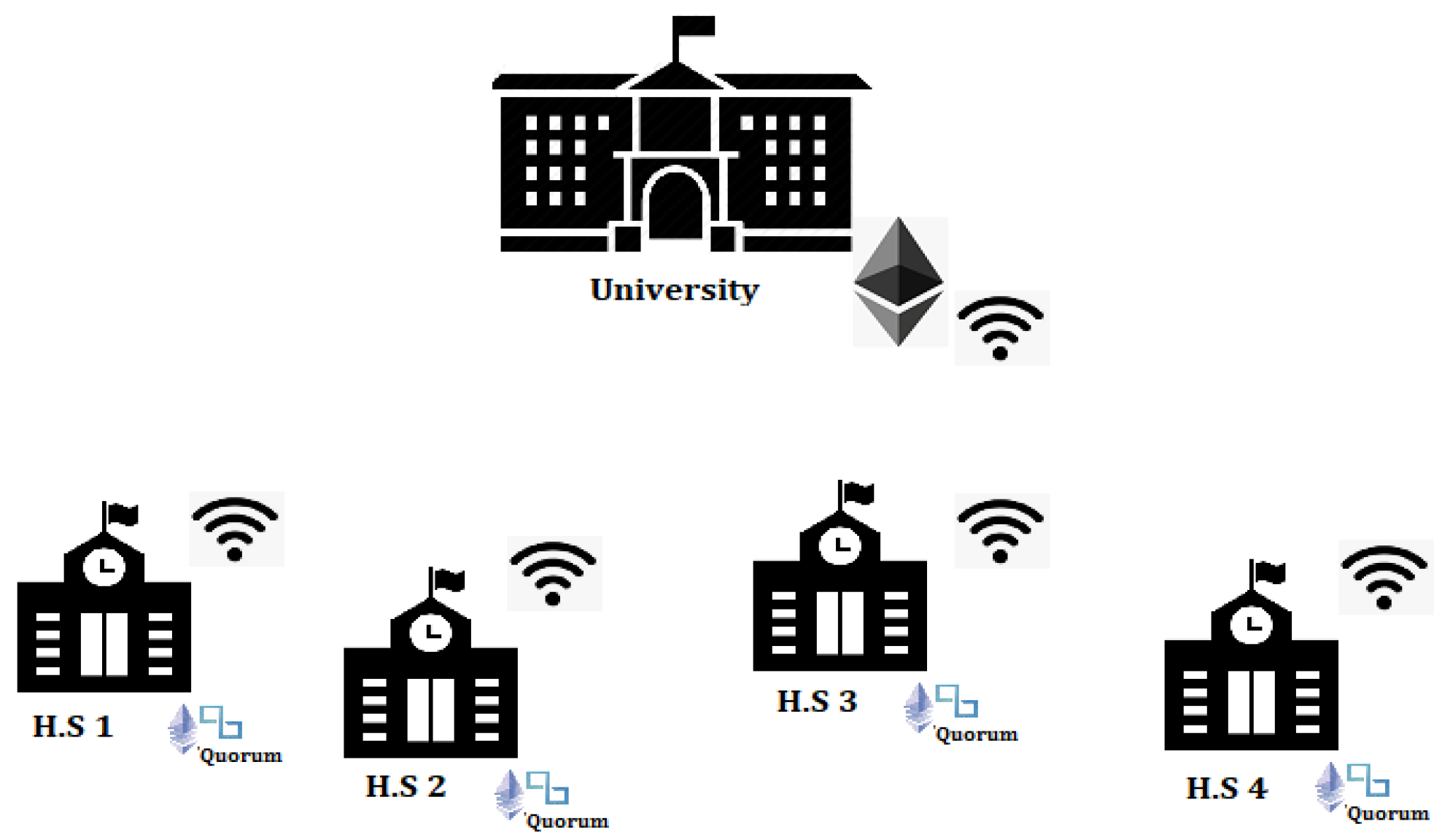
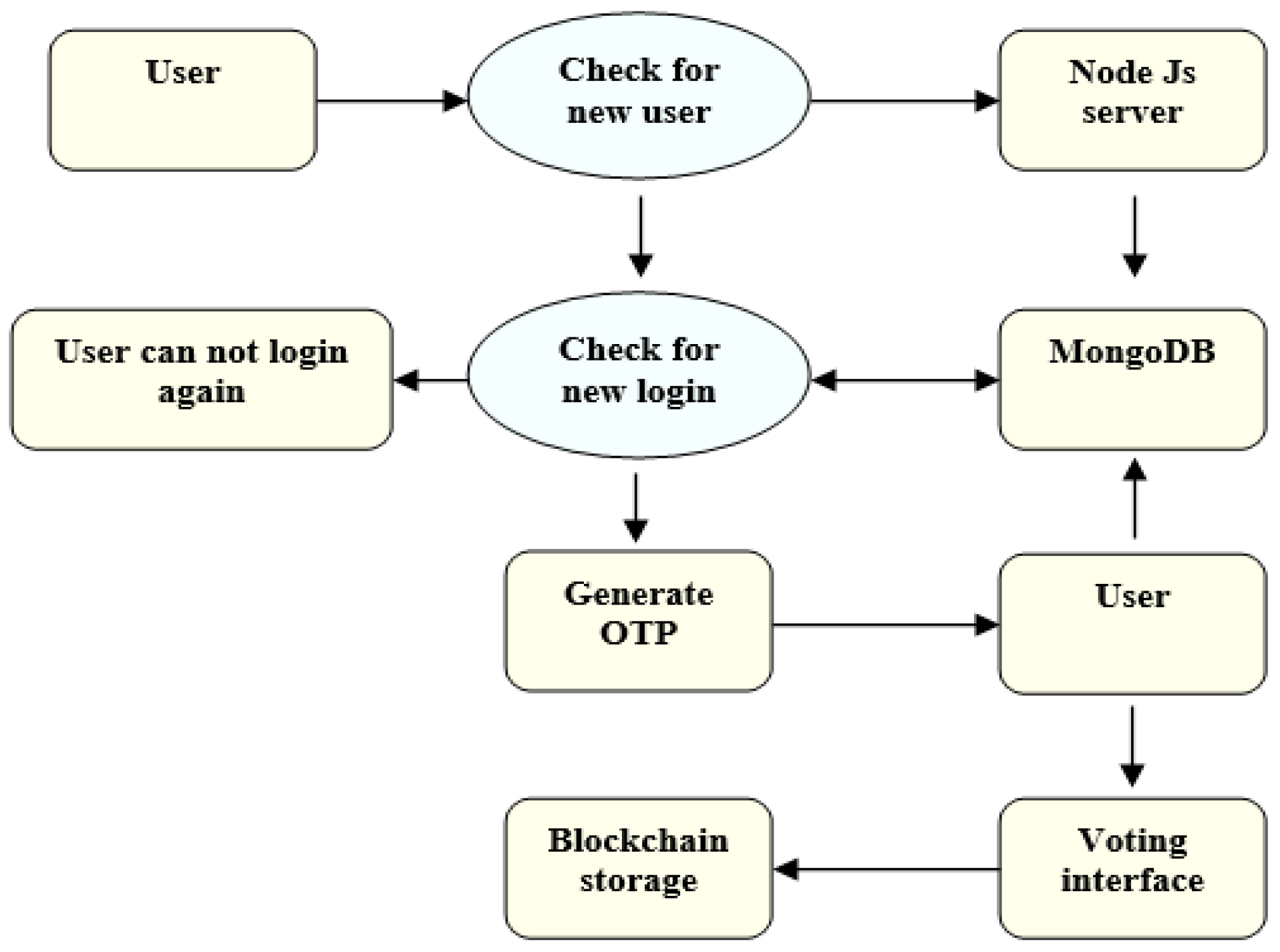

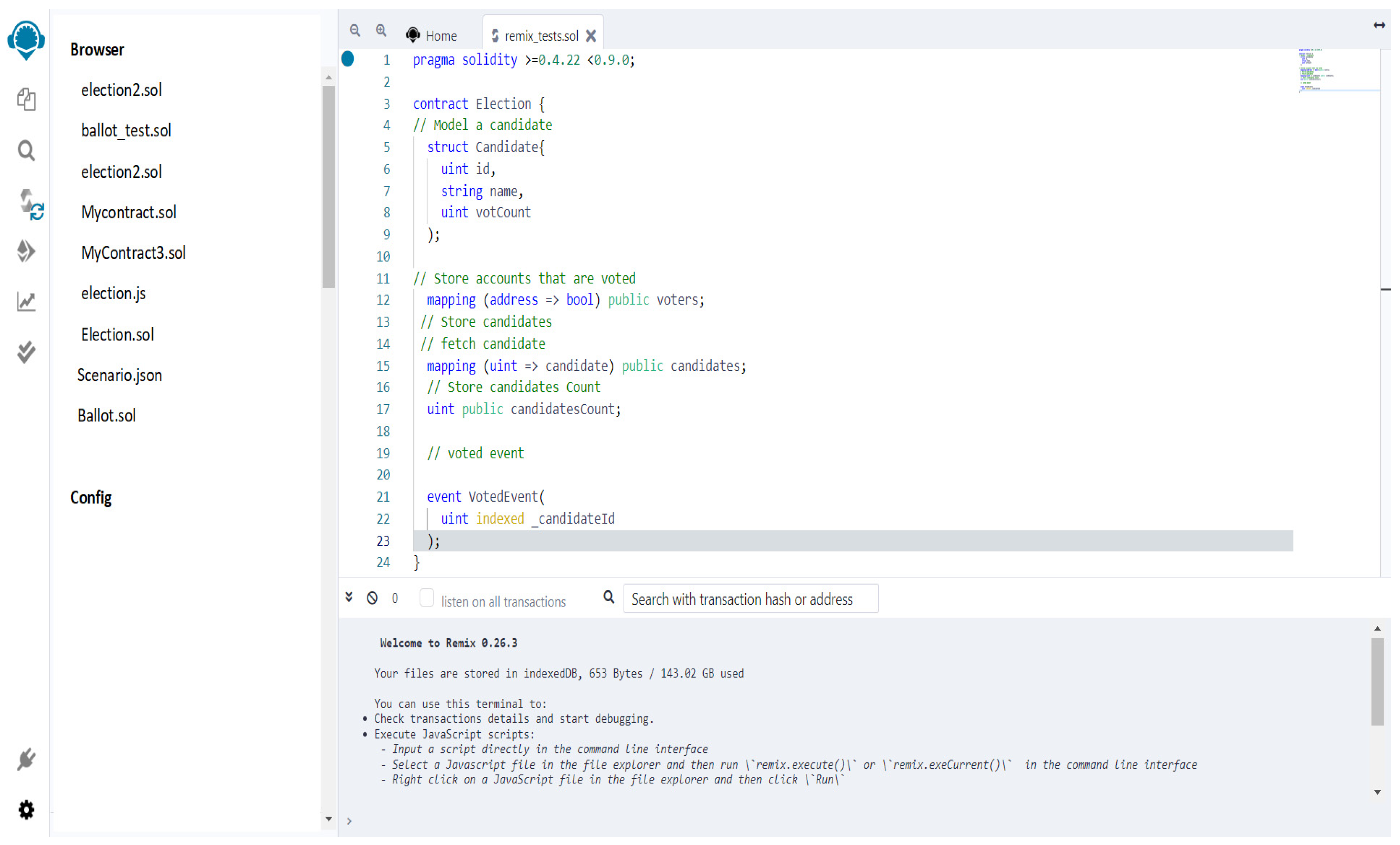


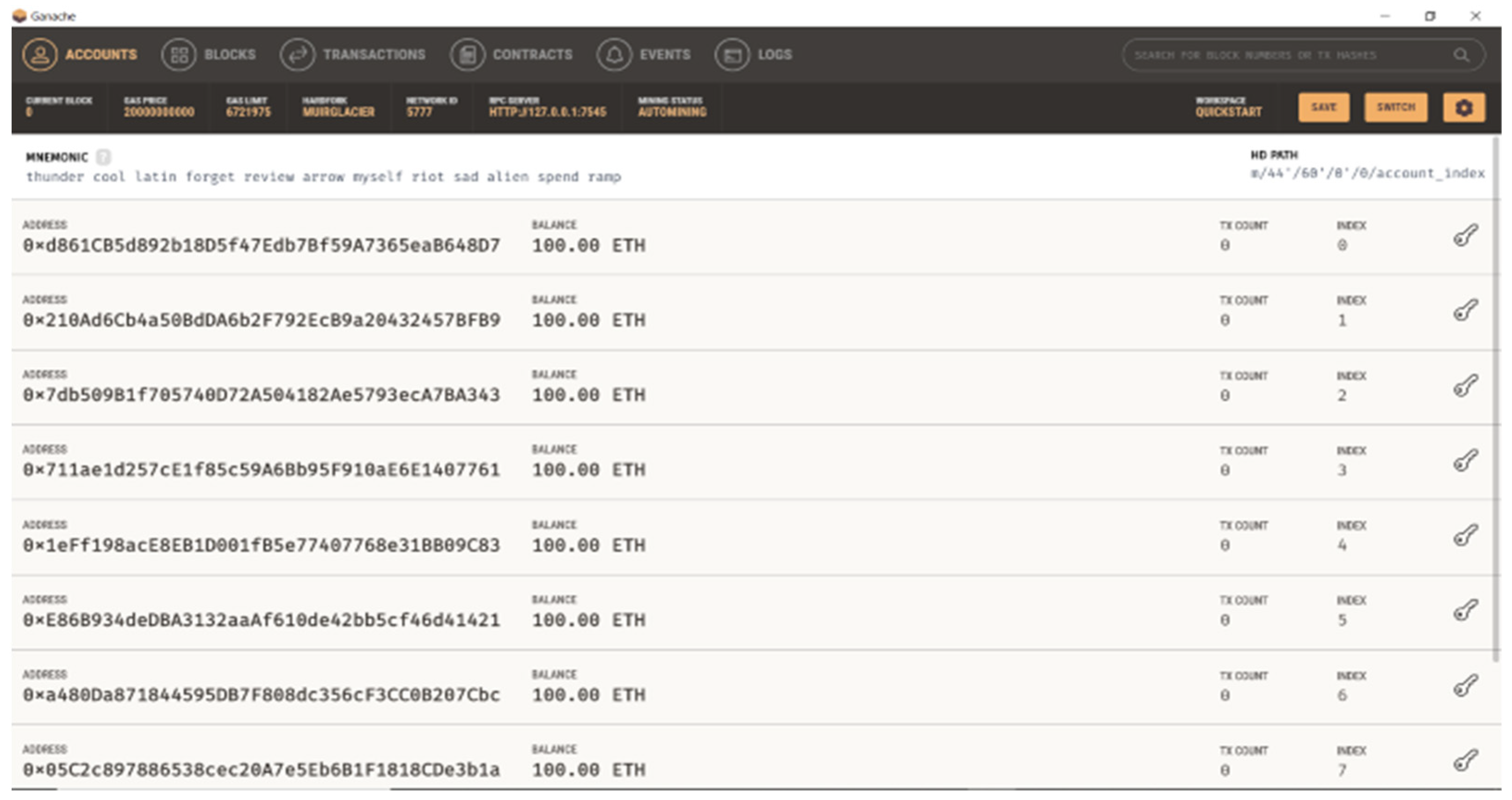
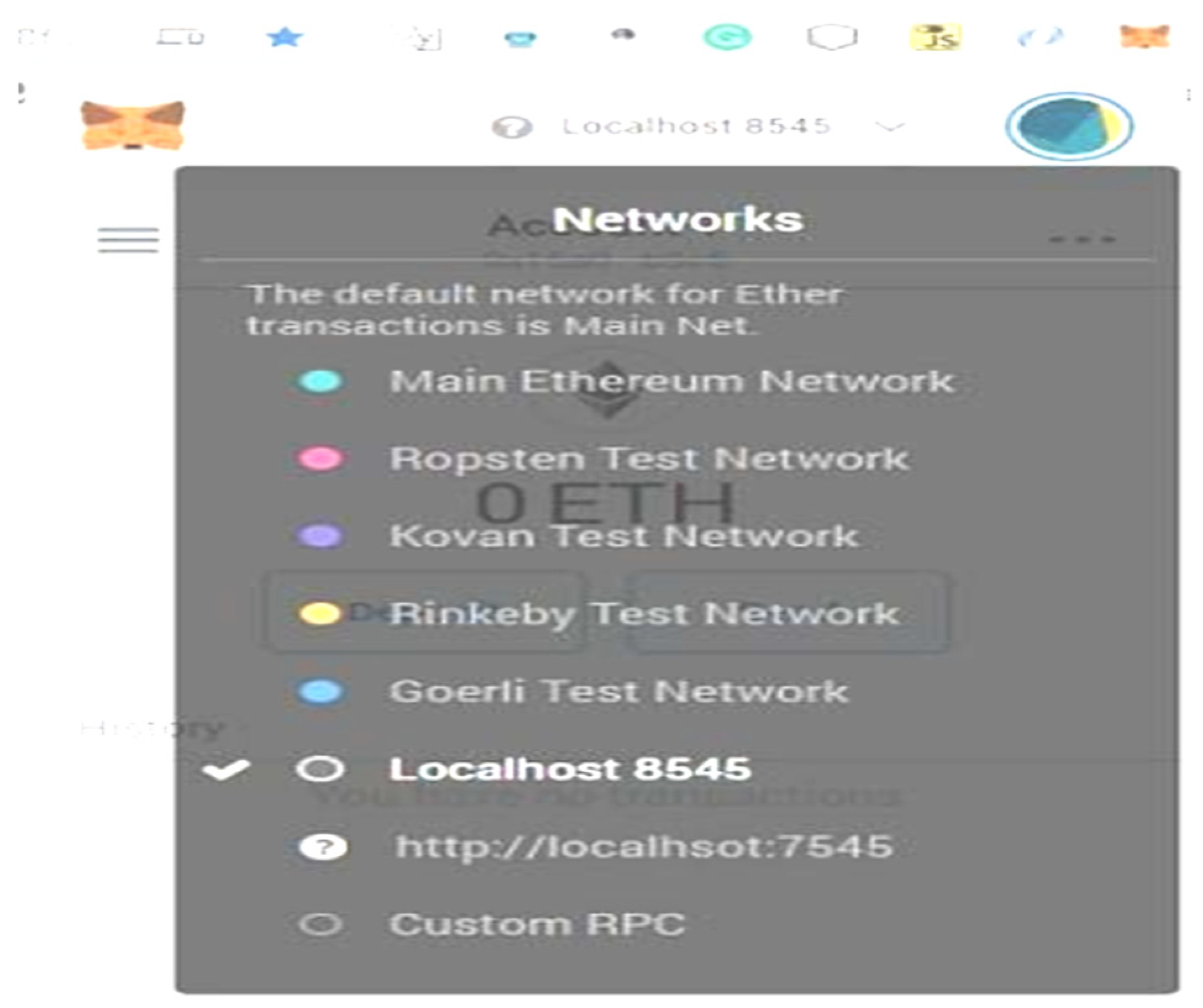
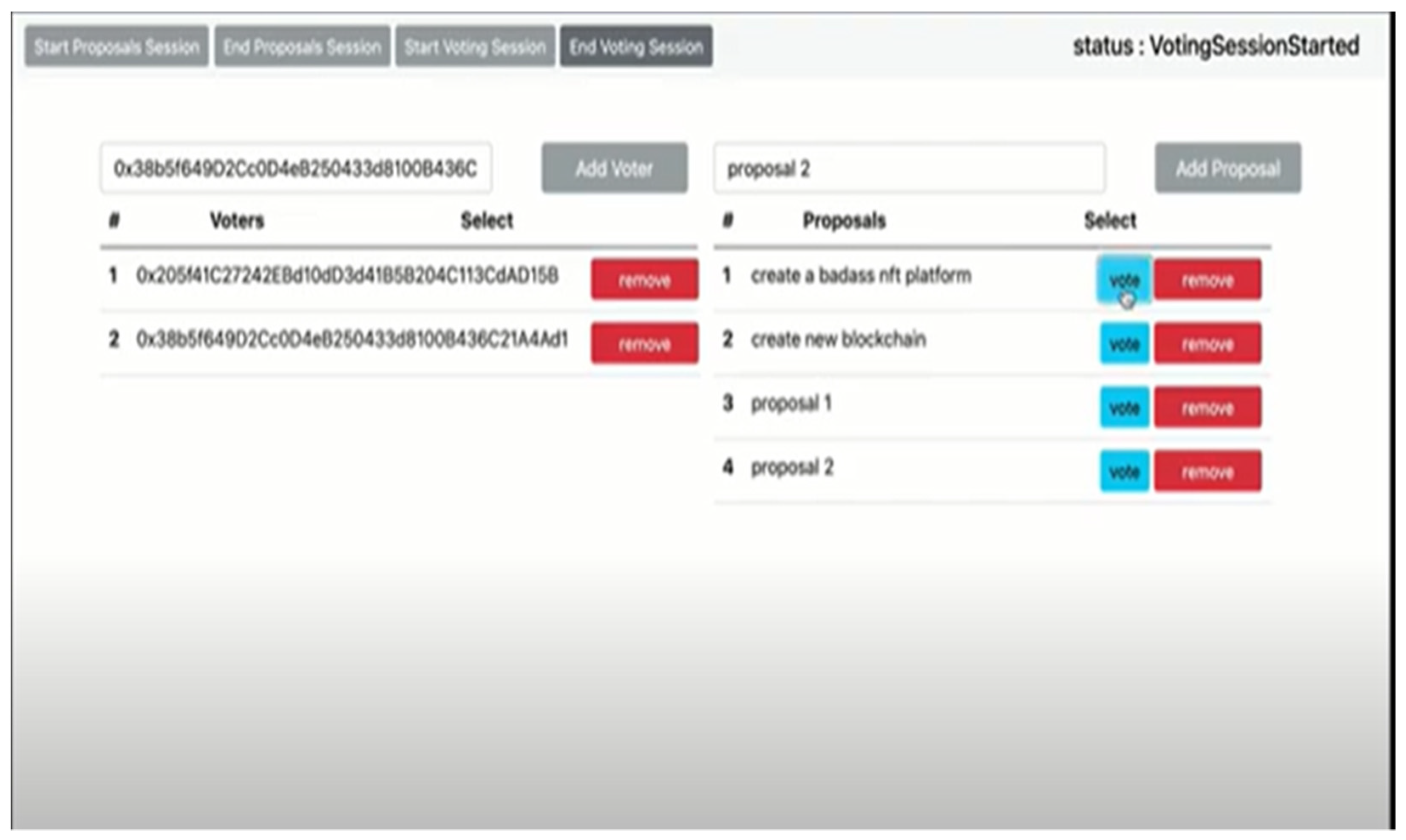
| Author | Decentralised with Blockchain | Framework | Consensus | Hashing Algorithm | Counting Method | Anonymity | Audit | Integrity | Scalability |
|---|---|---|---|---|---|---|---|---|---|
| Lai [38] | Yes | Ethereum | PoW | SHA-3 | Self-tally | Yes | No | No | Yes |
| Shahzad [39] | Yes | Bitcoin | PoW | SHA-256 | 3rd partie | Yes | Yes | Yes | No |
| Yi [40] | Yes | Bitcoin | PoW | SHA-256 | N-A | Yes | Yes | No | No |
| Rathee [42] | Yes | Ethereum | PoW | Not specified | Self-tally | Yes | No | Yes | Yes |
| Roopak [43] | Yes | Not specified | Not specified | SHA-256 | Self-tally | Yes | No | No | No |
| Krishna [44] | Yes | Not specified | PoW | AES-256 | Self-tally | Yes | Yes | No | Yes |
| Singh [45] | Yes | Not specified | Not specified | SHA-256 | Self-tally | Yes | No | Yes | No |
| Dery [46] | No | - | - | SSL | tallier module | Yes | No | Yes | Yes |
| El-Gburi [47] | No | - | - | El-Gamal algorithm | Self-tally | Yes | Yes | No | No |
| El Fezzazi [48] | Yes | Ethereum | Not specified | Not specified | Not specified | Yes | Yes | No | No |
| Gao [49] | Yes | Bitcoin | PBFT | Double SHA-256 | Self-tally | Yes | Yes | Yes | No |
| McCorry [50] | Yes | Ethereum | 2 Round-0 knowledge proof | Not specified | Self-tally | Yes | No | No | No |
| Our system | Yes | Ethereum & Quorum | PoW & PoS | SHA-256 | Self-tally | Yes | Yes | Yes | Yes |
| Xeon | Raspberry Pi | |
|---|---|---|
| Characteristics | X86-64 | ARM 7-8 |
| 3.5 GHz | 1.5 GHz | |
| 6 cores | 4 cores | |
| Cost ($) | 400 | 50 |
| Performance (IPS) | 185,000 | 11,000 |
| Power (W) | 128 | 4.9 |
| Power cost Per Instrucion (mW/Instr) | 0.70 | 0.44 |
Publisher’s Note: MDPI stays neutral with regard to jurisdictional claims in published maps and institutional affiliations. |
© 2022 by the authors. Licensee MDPI, Basel, Switzerland. This article is an open access article distributed under the terms and conditions of the Creative Commons Attribution (CC BY) license (https://creativecommons.org/licenses/by/4.0/).
Share and Cite
Chaabane, F.; Ktari, J.; Frikha, T.; Hamam, H. Low Power Blockchained E-Vote Platform for University Environment. Future Internet 2022, 14, 269. https://doi.org/10.3390/fi14090269
Chaabane F, Ktari J, Frikha T, Hamam H. Low Power Blockchained E-Vote Platform for University Environment. Future Internet. 2022; 14(9):269. https://doi.org/10.3390/fi14090269
Chicago/Turabian StyleChaabane, Faten, Jalel Ktari, Tarek Frikha, and Habib Hamam. 2022. "Low Power Blockchained E-Vote Platform for University Environment" Future Internet 14, no. 9: 269. https://doi.org/10.3390/fi14090269
APA StyleChaabane, F., Ktari, J., Frikha, T., & Hamam, H. (2022). Low Power Blockchained E-Vote Platform for University Environment. Future Internet, 14(9), 269. https://doi.org/10.3390/fi14090269






